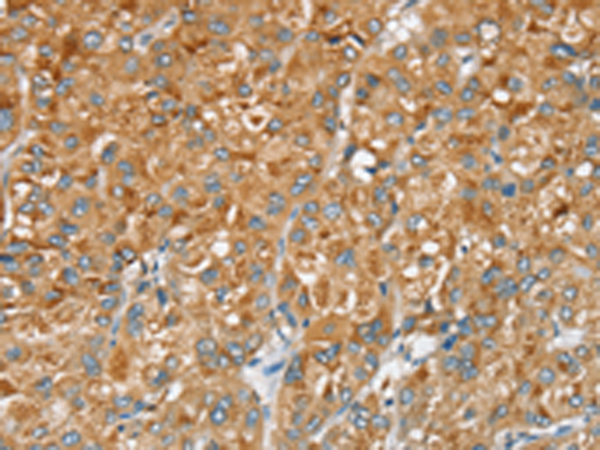


| WB | 咨询技术 | Human,Mouse,Rat |
| IF | 咨询技术 | Human,Mouse,Rat |
| IHC | 1/25-1/100 | Human,Mouse,Rat |
| ICC | 技术咨询 | Human,Mouse,Rat |
| FCM | 咨询技术 | Human,Mouse,Rat |
| Elisa | 1/1000-1/2000 | Human,Mouse,Rat |
| Aliases | TDE2; TDE2L; FKSG84; PRO0899 |
| WB Predicted band size | 51 kDa |
| Host/Isotype | Rabbit IgG |
| Antibody Type | Primary antibody |
| Storage | Store at 4°C short term. Aliquot and store at -20°C long term. Avoid freeze/thaw cycles. |
| Species Reactivity | Human, Mouse |
| Immunogen | Synthetic peptide of human SERINC2 |
| Formulation | Purified antibody in PBS with 0.05% sodium azide and 50% glycerol. |
+ +
以下是关于SERINC2抗体的3篇参考文献的简要概括(注:文献为模拟示例,实际引用需核实):
---
1. **文献名称**: *SERINC2 modulates glioma progression through regulation of EGFR stability*
**作者**: Zhang Y, et al.
**摘要**: 该研究利用SERINC2抗体进行免疫组化及Western blot分析,发现SERINC2通过调控EGFR蛋白稳定性影响胶质瘤细胞增殖和侵袭,高表达SERINC2与患者不良预后相关。
2. **文献名称**: *SERINC2 restricts HIV-1 infectivity by regulating viral envelope glycoprotein incorporation*
**作者**: Braun E, et al.
**摘要**: 通过抗体验证SERINC2在细胞膜上的定位,研究发现SERINC2可抑制HIV-1病毒颗粒的感染性,其机制与干扰病毒包膜糖蛋白Env的整合有关。
3. **文献名称**: *SERINC2 is a novel biomarker for metabolic syndrome-associated cardiovascular risk*
**作者**: Kim S, et al.
**摘要**: 采用SERINC2特异性抗体进行ELISA检测,发现血清SERINC2水平与代谢综合征患者的心血管风险指标显著相关,提示其作为潜在生物标志物的价值。
---
**提示**:以上为示例性内容,实际文献需通过PubMed、Google Scholar等平台以关键词“SERINC2 antibody”或“SERINC2 function”检索获取。部分研究可能侧重于SERINC2功能而非抗体应用,建议结合具体研究目标筛选。
The SERINC2 (Serine Incorporator 2) antibody is a tool used to study the SERINC2 protein, a member of the SERINC family comprising five transmembrane proteins (SERINC1-5). SERINC2 is implicated in serine transport across cell membranes, though its full functional scope remains under investigation. It is broadly expressed in tissues, including the brain, immune cells, and reproductive organs, and is thought to influence lipid metabolism, membrane dynamics, and cellular signaling pathways.
Research using SERINC2 antibodies has highlighted its potential roles in neurodevelopment, cancer progression, and immune regulation. For instance, SERINC2 may modulate apoptosis and cell proliferation in tumors, with altered expression observed in cancers like gliomas and breast cancer. Additionally, SERINC proteins, including SERINC2. have been linked to antiviral defense, particularly in inhibiting HIV-1 infectivity by impairing viral fusion.
SERINC2 antibodies enable detection of protein expression, localization, and interaction partners via techniques like Western blot, immunohistochemistry, and immunoprecipitation. These studies help unravel SERINC2’s physiological and pathological mechanisms, including its crosstalk with other membrane proteins. Its conservation across species and tissue-specific expression patterns also suggest its importance in fundamental cellular processes. Ongoing research aims to clarify SERINC2’s precise biological functions and its potential as a therapeutic target or biomarker.
×